This tantanmen recipe is made up of a healthy, hearty, warm vegan ramen noodles soup packed with aromatic flavors, a balance of spice and creaminess, a hint of peanut butter, and protein-rich vegan mince for a delicious meat-free dinner! This Japanese take on the popular Sichuan Dan Dan Noodles is sure to be a crowd-pleaser for any ramen lover!
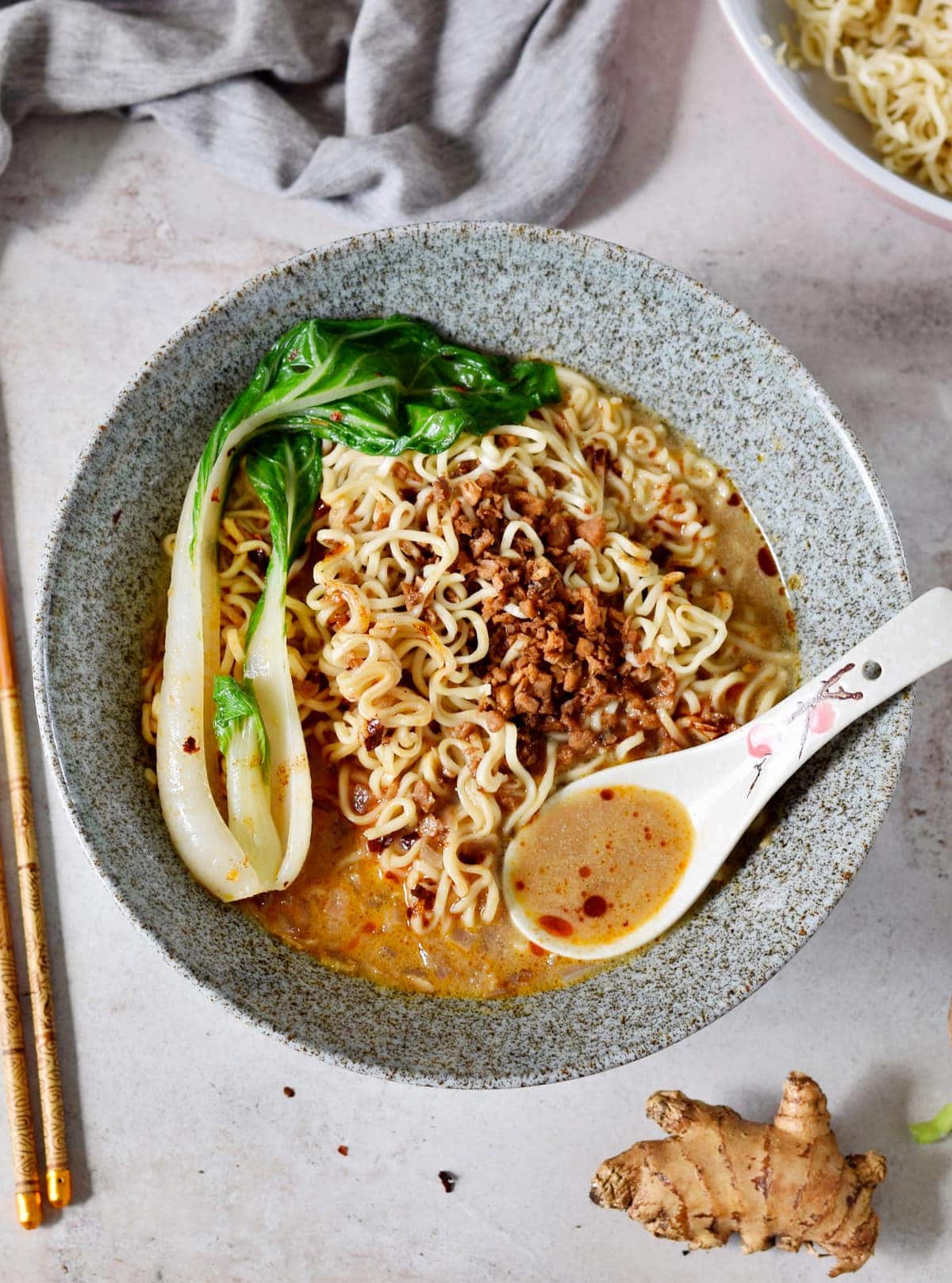
When it comes to Asian cuisines of all types, I’m hooked! In fact, I’ve already veganized and shared recipes for creamy vegan ramen noodles, vegetable gyoza, cabbage rolls, Hibachi-style fried rice, and spicy sriracha noodles. Now it’s the turn of tan tan ramen.
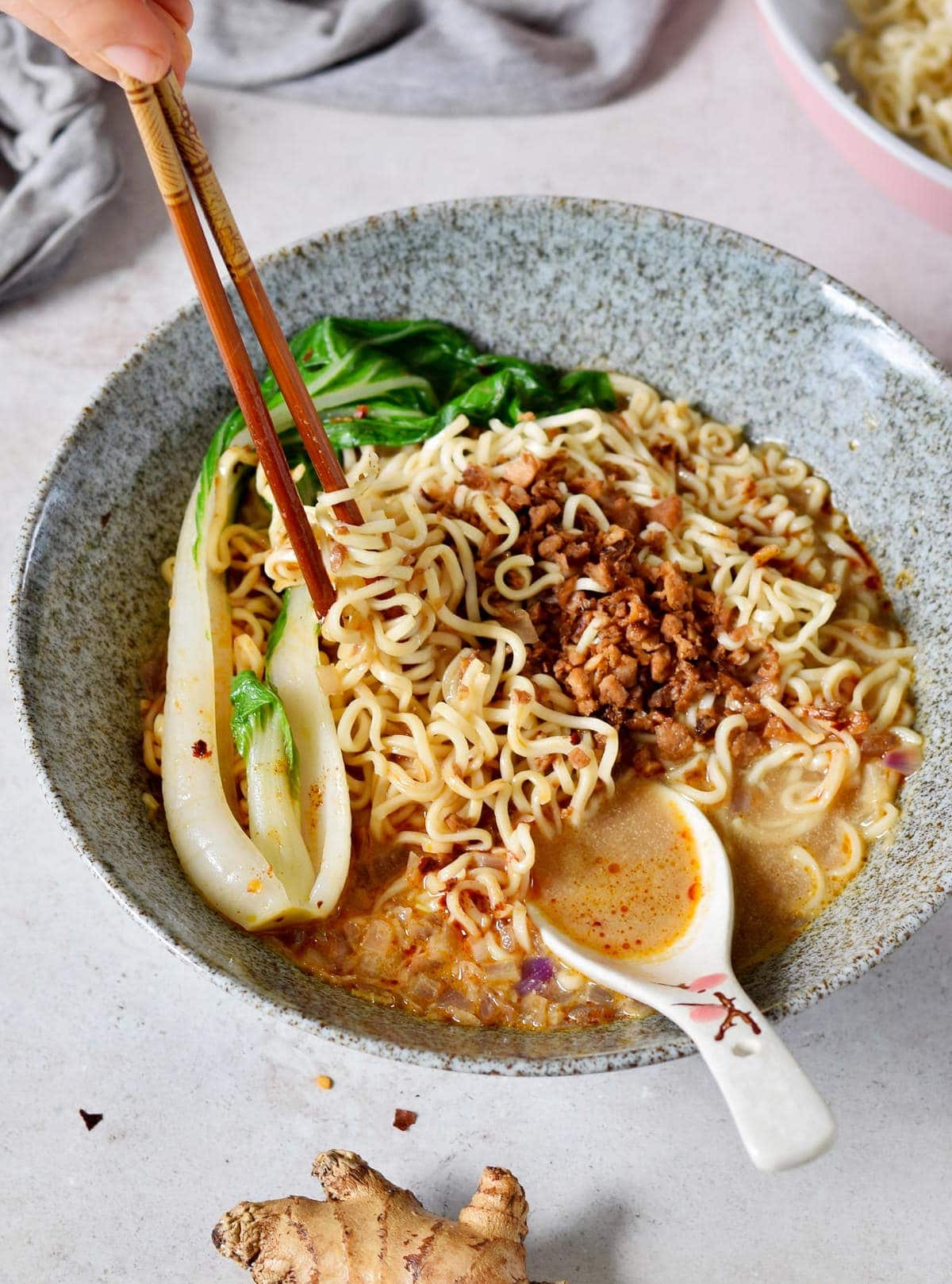
What Is Tan Tan Ramen?
Tantanmen is the Japanese version of a Chinese dish called Dandanmian (担担面) aka Dan Dan noodles (or Dandan noodles).
Traditionally dan dan noodles contained preserved vegetables with a spicy sauce and minced pork over noodles – served dry or as a soup. There are several local variations and some international, including the use of sesame paste and/or peanut butter in the American Chinese version of dan dan and tan tan noodles.
Tantanmen (also called tantan ramen, tan tan ramen, and tan tan noodles) is a ramen dish served with spicy chili and sesame soup. It traditionally contains either spinach or Bok Choy (Pak Choi) with minced pork and is garnished with scallions and chili.
However, this flavorful vegan ramen recipe ditches the meat and meaty broth for a spicy, aromatic vegan textured protein served up in a spicy veggie broth with a hint of peanut butter and tahini flavor alongside aromatics including garlic, onion, ginger, and chili oil.
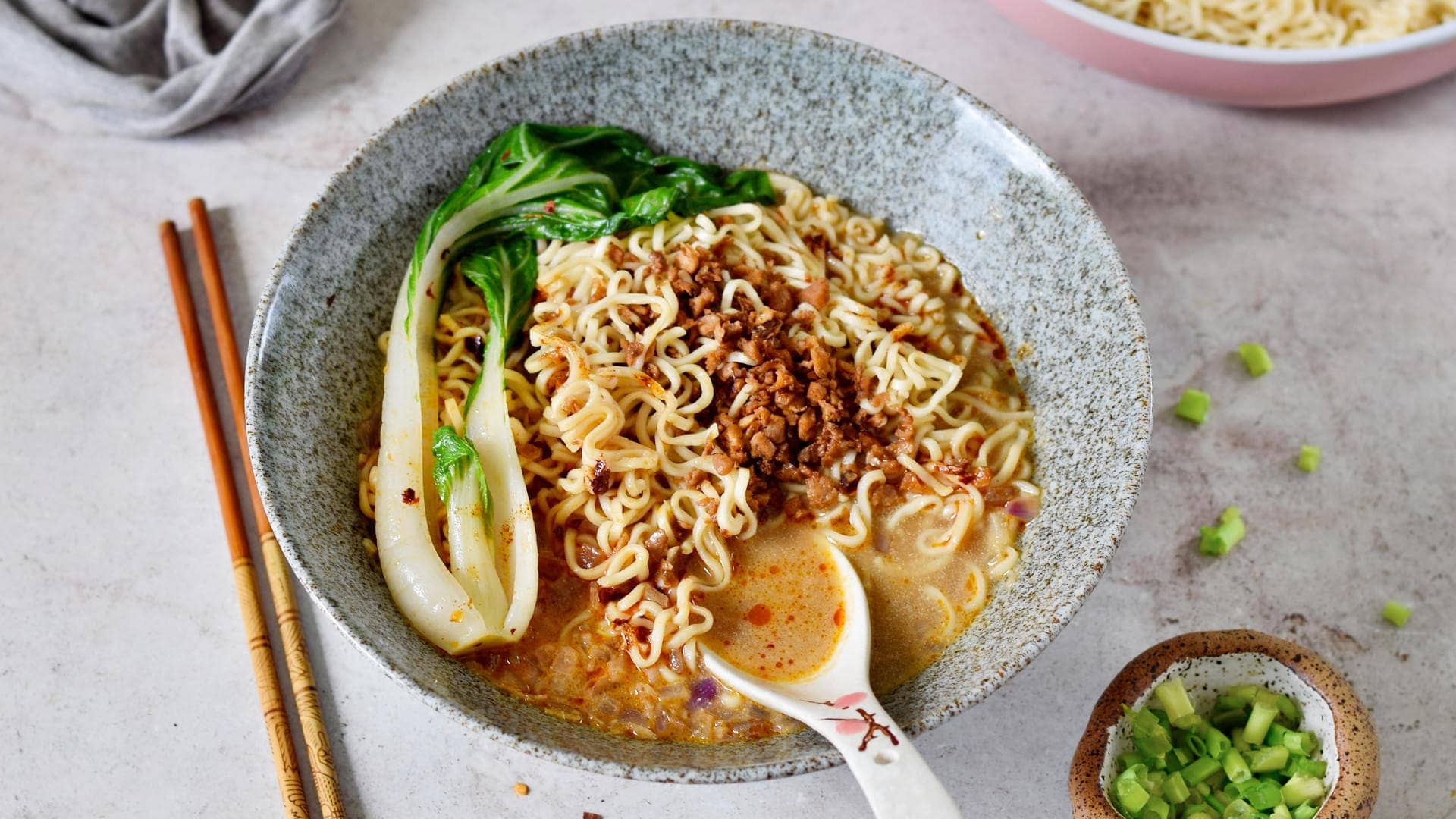
The Ingredients
These are the ingredients you’ll need for the vegan mince:
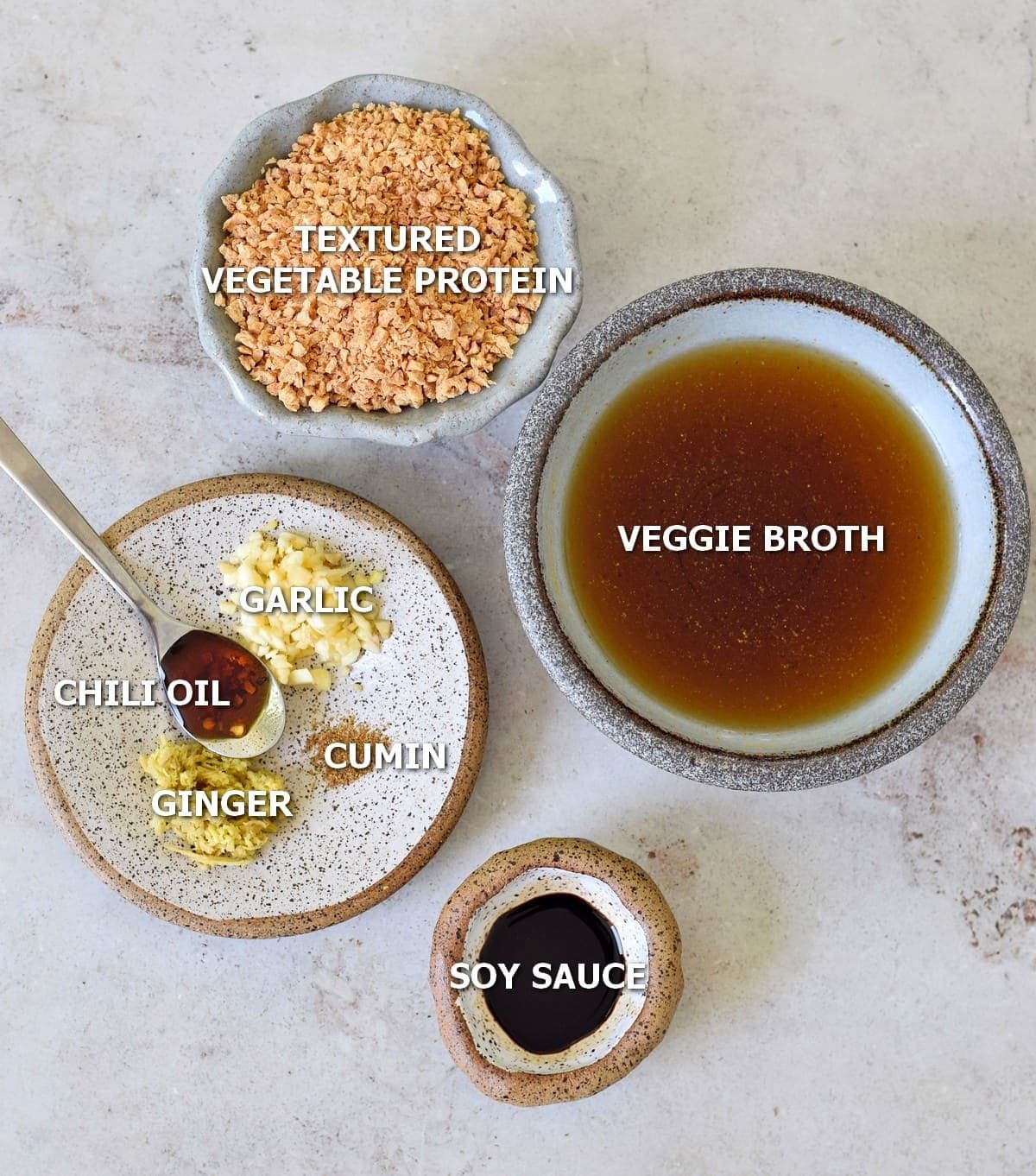
You’ll also need the vegan ramen noodles, and veggies like bok choy and scallions:
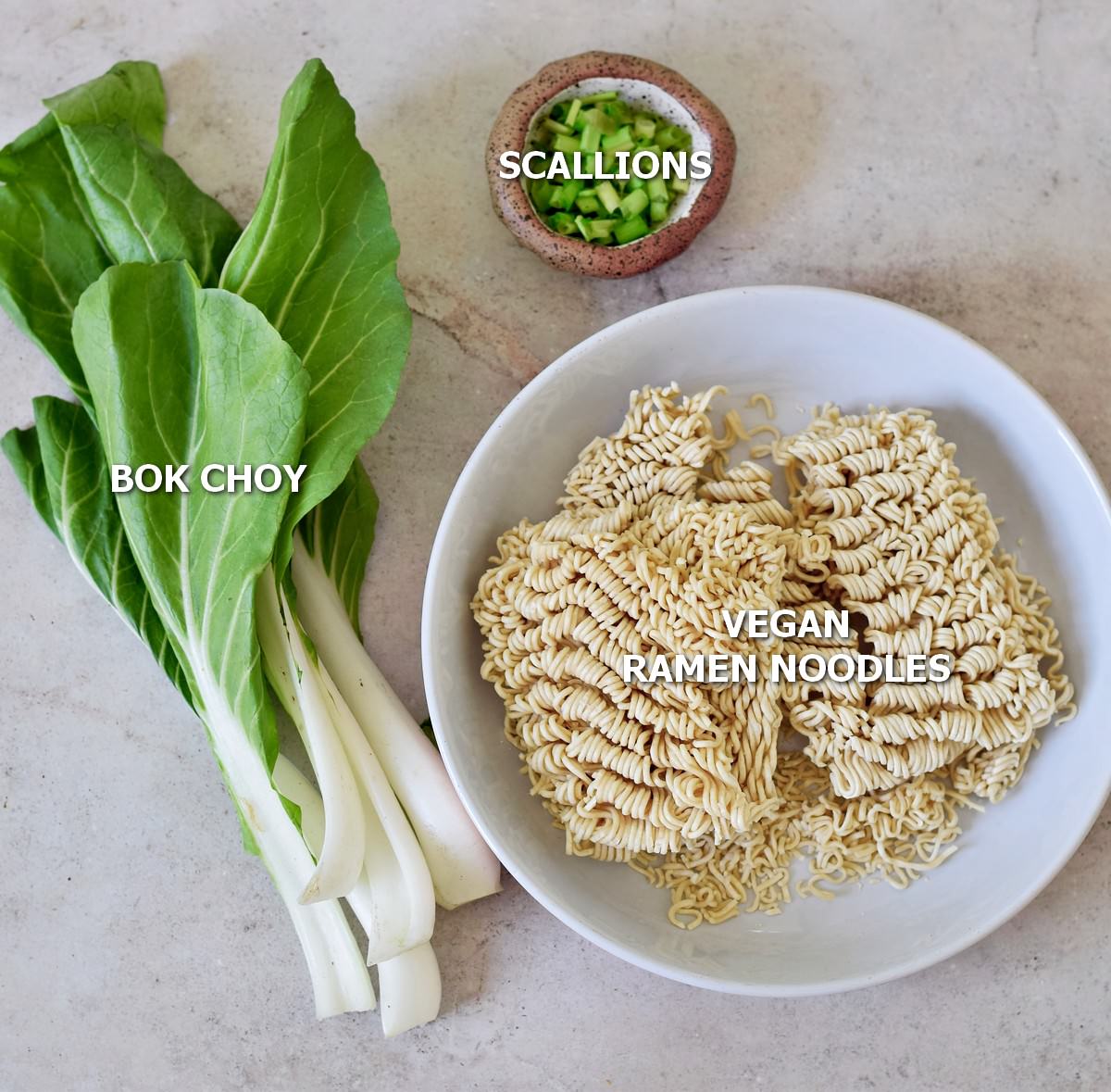
And for the vegan ramen soup, you’ll need these ingredients:
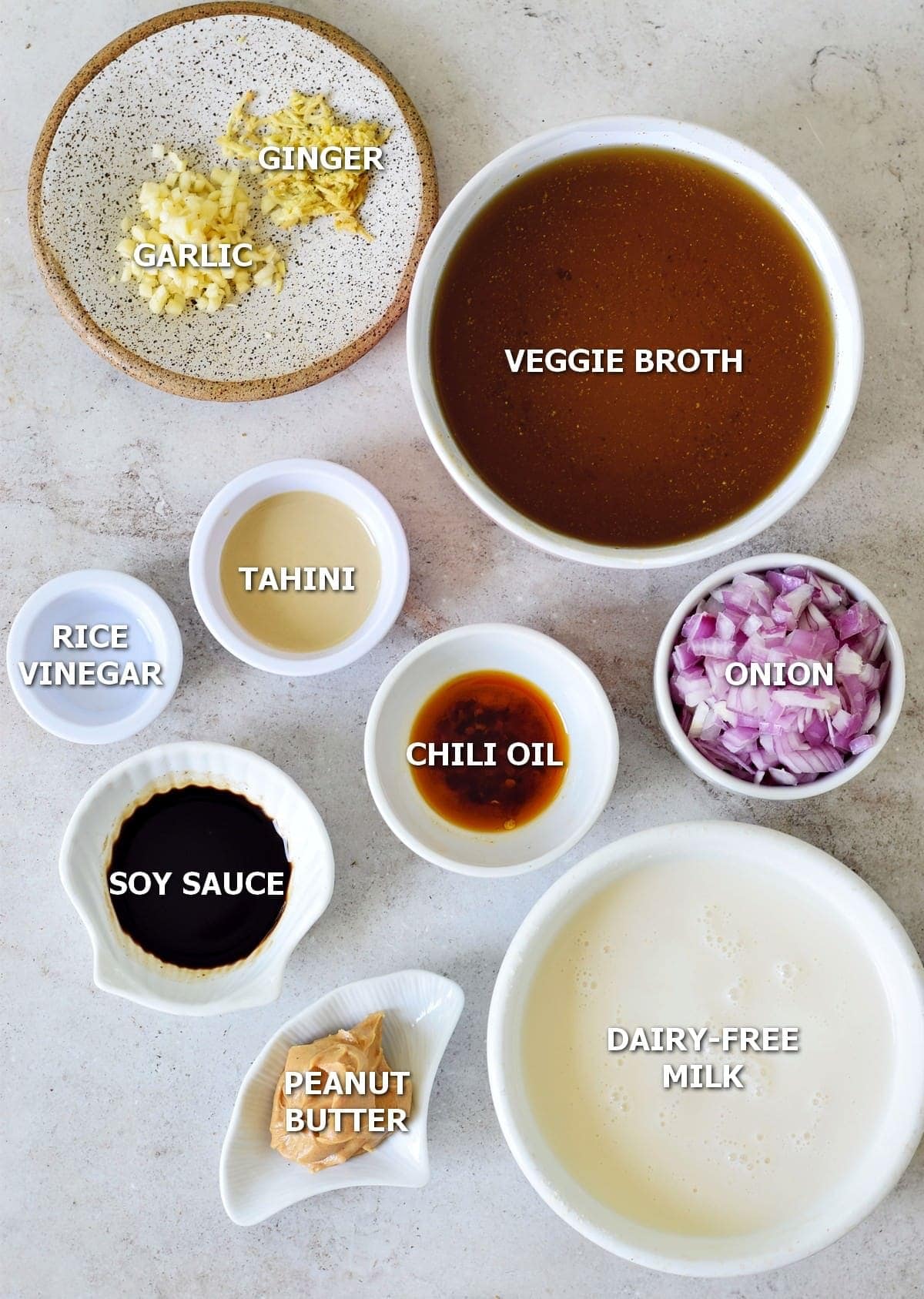
For the full ingredients list, measurements, complete recipe method, and nutritional information, please check out the recipe card at the bottom of this post.
How To Make Tantanmen
Preparing tantanmen is simple but requires focusing on three separate elements: the ramen soup broth, the noodles and toppings, and the vegan mince.
Step 1: Prepare the vegan mince
- Add the textured vegan protein to a medium bowl and pour over the hot vegetable broth (or water). Allow it to sit for five minutes to rehydrate, drain it, and squeeze out any excess liquid.
- Then, in a large skillet, heat the chili oil over medium heat and sauté the garlic and ginger for 1-2 minutes, stirring frequently. Add the cumin, salt and pepper, and soy sauce (or tamari for gluten-free) and mix in well. Then turn off the heat and set the mixture aside.
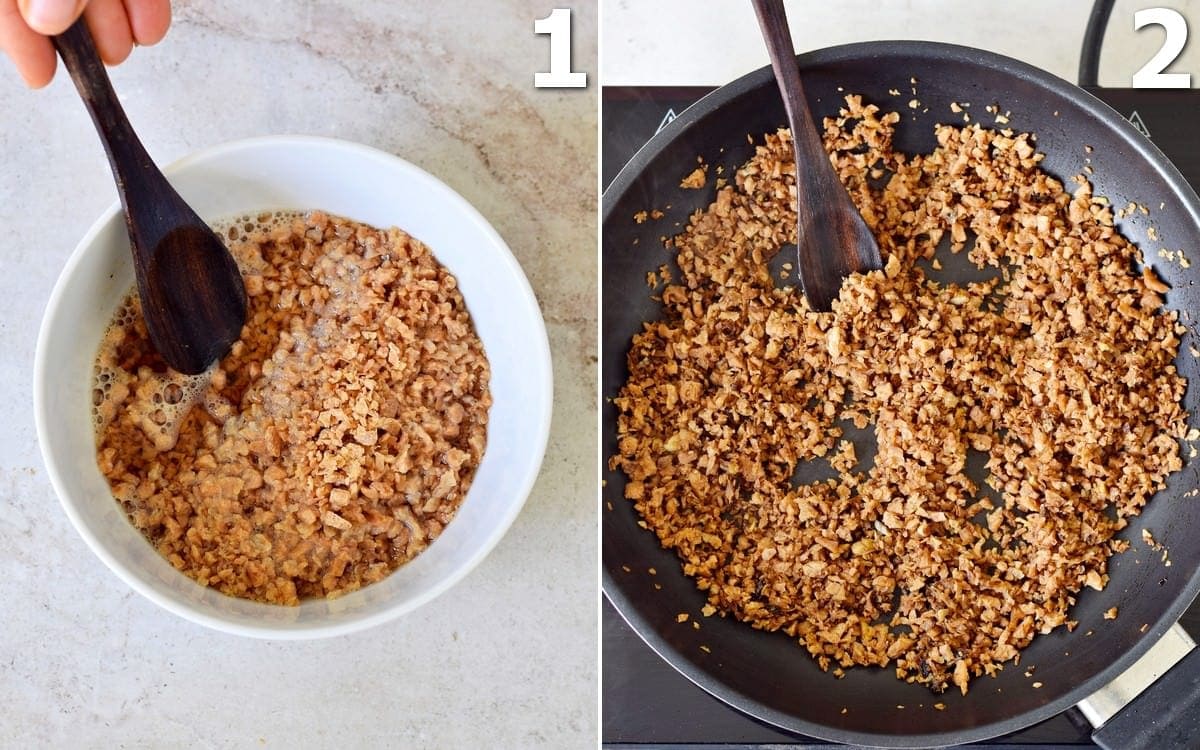
Step 2: Prepare the noodle and toppings
- Bring a large pot of salted water to a boil and then add the bok choy leaves, boiling them for 2 minutes until tender. Use tongs or a fork to remove them and set them aside.
- Then, add the ramen noodles (or rice noodles) to the same pot and cook until al dente – they should be a bit chewy still, not soft. Once they’re ready, you can drain the water.
- Next, finely chop the scallions and place them and the chili oil in different bowls, ready to garnish.
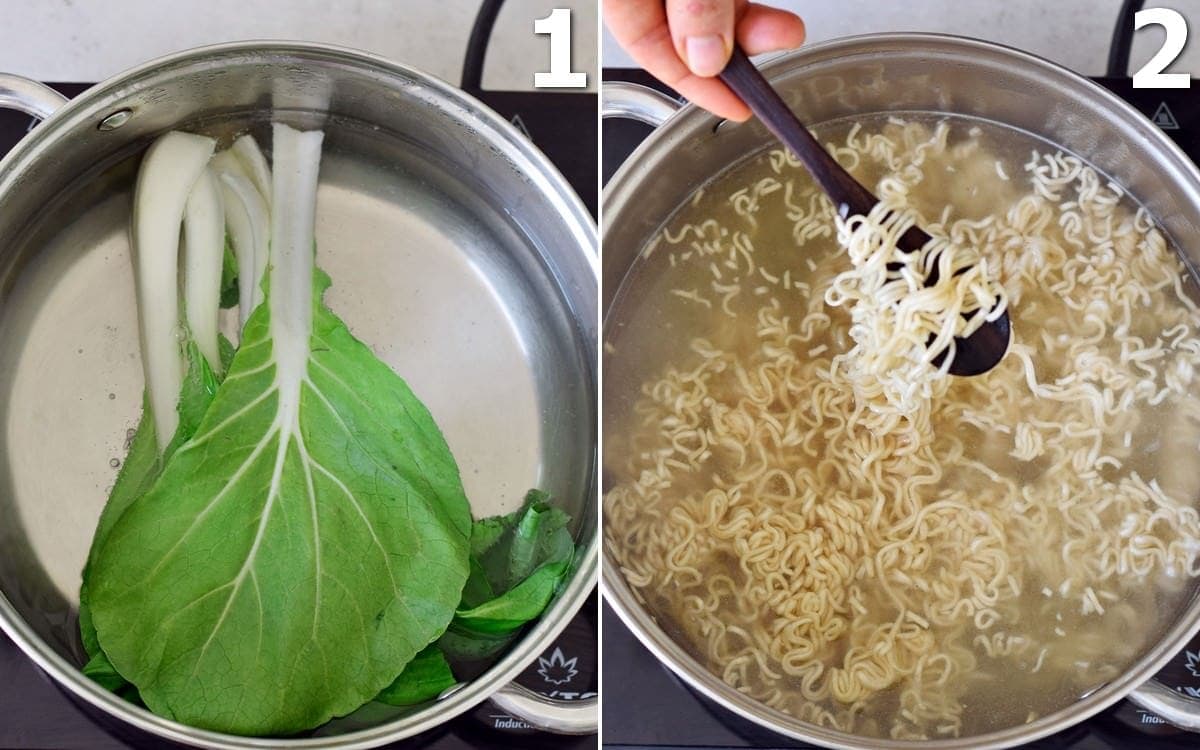
Step 3: Prepare the tan tan ramen soup broth
- First, heat the chili oil in a large skillet over medium heat and sauté the ginger, garlic, and onion for a few minutes, stirring frequently. Then add the tahini (or sesame paste) and peanut butter, stirring to combine.
- Next, add the dairy-free milk and the vegetable broth and bring the mixture to a boil. Once boiled, reduce the heat to medium-low and allow the soup to simmer for a few minutes.
- Finally, add salt and pepper, plus optionally more soy sauce, rice vinegar, or spices to taste.
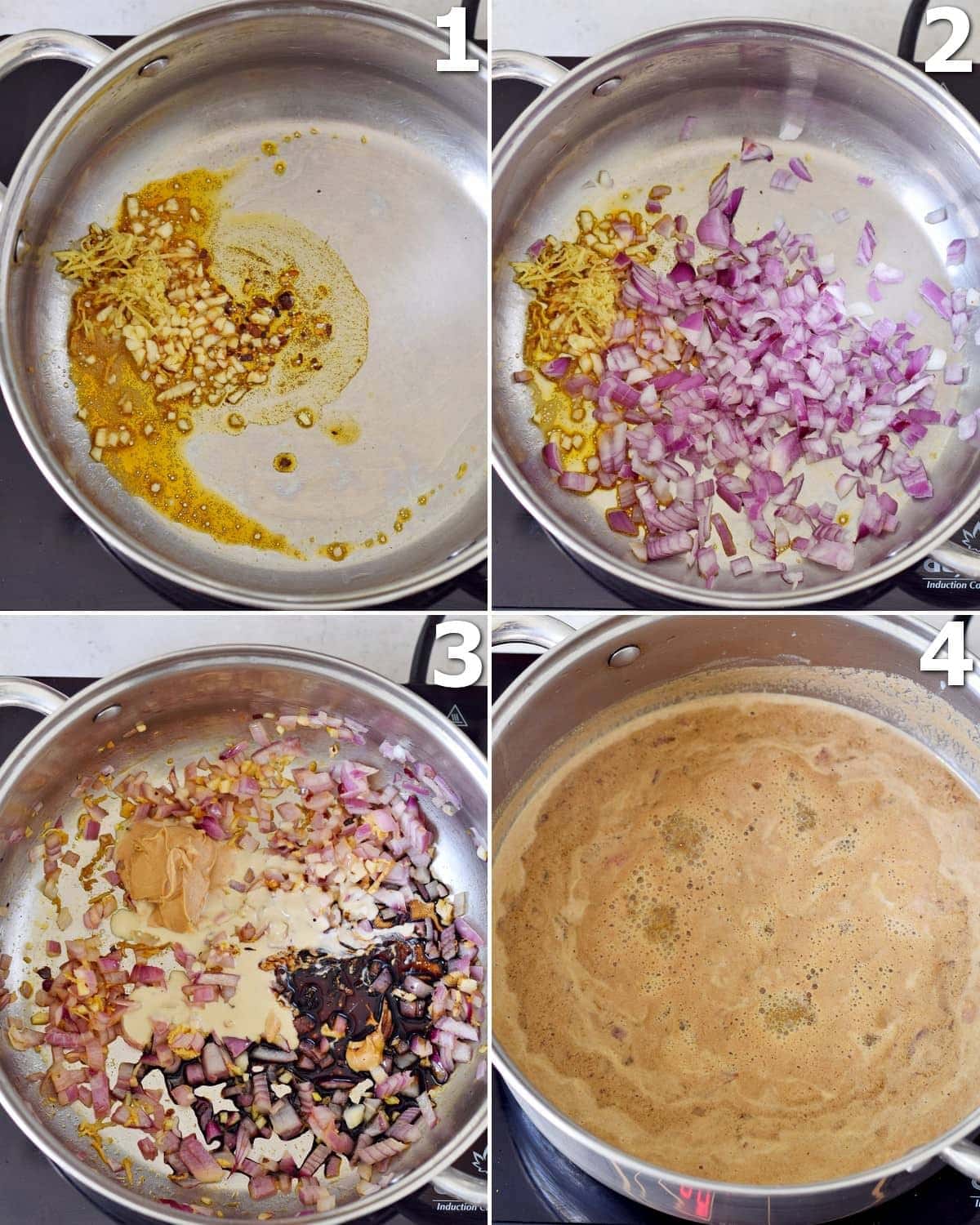
Step 4: Assemble the tantanmen
- Add the cooked noodles and mince to the bowls, pour in the ramen soup broth, and then top with the bok choy, scallions, and chili oil- enjoy your tantan ramen!
How to Make Ahead and Store?
To make ahead: You can prepare the broth and vegan mince elements 2-3 days in advance and store them separately until you’re ready to continue with the recipe. However, I like to cook the noodles and toppings (bok choy) fresh for the tantanmen as I don’t want their quality to decline too much before eating them.
To Store: Once prepared and topped, I prefer to eat my tan tan ramen immediately for the best flavor and texture. However, you can store any leftovers in an airtight container in the refrigerator for between 1-2 days.
To reheat: Reheat the tan tan noodles on the stovetop or in the microwave. It may affect the noodle texture slightly but should still taste great!
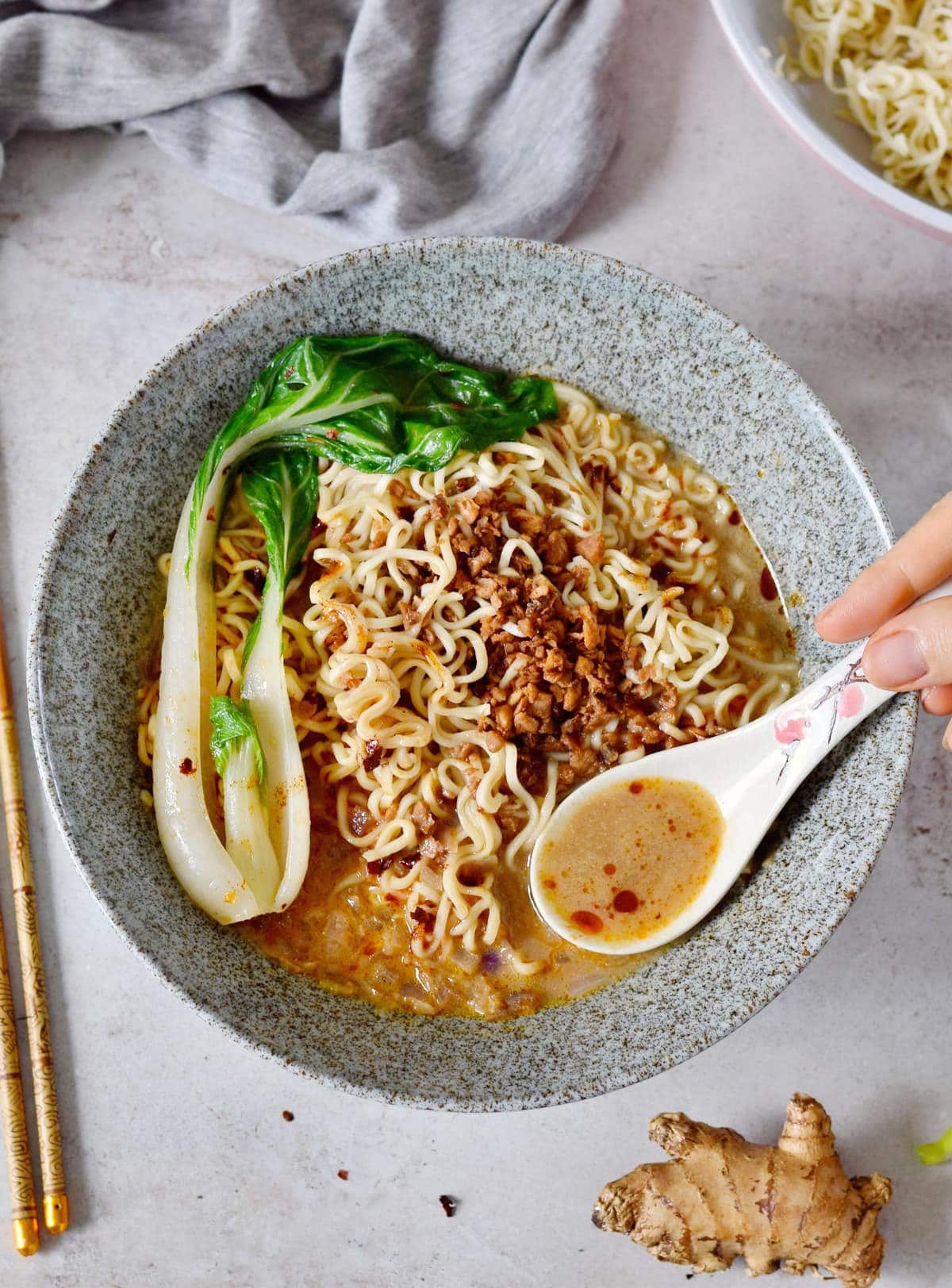
Recipe Notes & Variations
- Adjust the heat level: To adjust how spicy this tan tan ramen is, adjust the amount of chili oil used. You can optionally substitute the chili oil for toasted sesame oil for a mild version.
- Save the noodle water: Keep the drained vegan ramen noodles water to use in other stocks and broths. You can store it for several days in the fridge or freeze it into ice-cube trays for longer storage. Don’t use the salted water on plants as the salt may kill them.
- Tahini vs. Chinese sesame paste: I’ve recommended that you can use either, based on what is available. However, the Chinese sesame paste uses raw sesame seeds. If you can get raw tahini, this would create the most authentic flavor.
- For a nut-free version: You could increase the sesame paste, though the flavor won’t be the exact same. I wouldn’t recommend omitting the peanut butter unless you really must.
- Instead of the vegetable protein: You could use shredded frozen tofu. Once frozen and thawed, tofu’s texture changes and becomes meatier, with a bit more ‘bite’- which is excellent for this vegan dish.
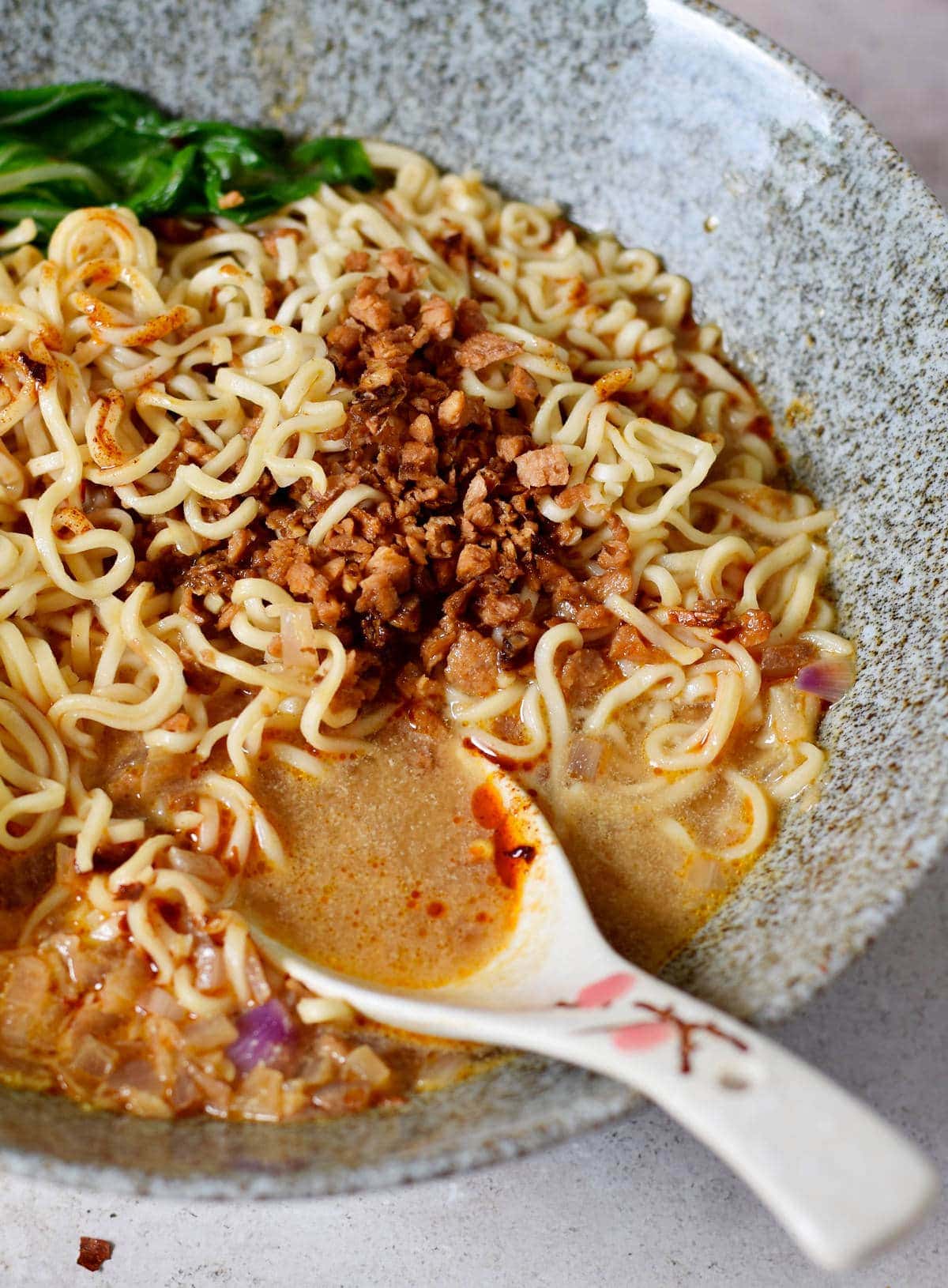
Other Vegan Asian-Inspired Recipes
- Asian Vegetable Stir-Fry Noodles
- The Best Peanut Butter Noodles
- Sticky Teriyaki Tofu with Sweet And Sour Sauce
- Garlic Broccoli Stir Fry With Chickpeas
- Chinese Garlic Sauce
- Homemade Hoisin Sauce
If you try this tantanmen recipe, I’d love a comment and ★★★★★ recipe rating below. Also, please don’t forget to tag me in re-creations on Instagram or Facebook with @elavegan and #elavegan – I love seeing them.
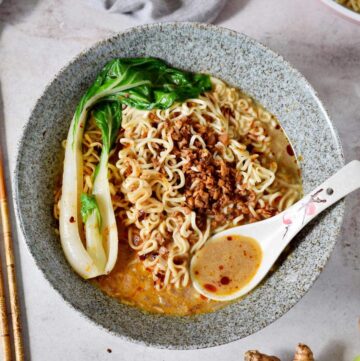
Tantanmen ramen
Ingredients
Vegan mince
- 2/3 cup (55 g) textured vegetable protein (or use meatless crumbles)
- 2/3 cup (160 ml) hot vegetable broth or water
- 1-2 tsp chili oil or toasted sesame oil
- 2 cloves of garlic minced
- 1 tsp fresh ginger grated
- 1/4 tsp ground cumin
- Salt and pepper to taste
- 1 tbsp soy sauce or tamari, or coconut aminos
Noodles and toppings
- 5-6 leaves of bok choy
- 6 oz (170 g) dry vegan ramen noodles or rice noodles
- 3 tbsp chopped scallions
- 1-2 tsp chili oil or toasted sesame oil, to drizzle (optional)
Soup
- 2 tsp chili oil or toasted sesame oil
- 2 cloves of garlic minced
- 1 tsp fresh ginger grated
- 2 green onions or 1 medium red onion
- 1 1/2 tbsp tahini or sesame paste
- 2 tbsp peanut butter
- 1 1/2 tbsp soy sauce
- 1 tbsp rice vinegar optional
- 1 cup (240 ml) dairy-free milk
- 2 cups (480 ml) vegetable broth
- Salt and black pepper to taste (I used 1 tsp salt)
Instructions
Vegan mince
- Watch the video in the post for visual instructions.Add the textured vegetable protein to a medium bowl and pour in the hot vegetable broth (or water). Let it sit for about 5 minutes to rehydrate, then drain and squeeze out the liquid.
- Heat the chili oil in a skillet over medium heat and sauté the garlic and ginger for 1-2 minutes, stirring frequently. Also, stir in the spices (cumin, salt, pepper), and the soy sauce (or tamari). Turn off the heat and set aside.
Noodles and toppings
- Fill a large pot with water (and some salt) and bring it to a boil. Once it boils, add the bok choy leaves and cook them for about 2 minutes until softened. Take them out with tongs or a fork and set aside.
- Add the ramen noodles (or rice noodles) to the same boiling water and cook until al dente (they should be still chewy, not soft), then drain.
- Finely chop the scallions and set them aside in a small bowl, along with the chili oil in a different bowl to garnish.
Soup
- Heat the chili oil in a skillet over medium heat and sauté the garlic, ginger, and onion for a few minutes, stirring frequently. Add the tahini (or sesame paste), peanut butter, and rice vinegar (if using), then stir to combine.
- Next, add the dairy-free milk and the vegetable broth and bring the soup to a boil. Reduce the heat to low-medium and let the soup simmer for a few minutes. Finally, add salt and pepper, plus optionally more soy sauce, rice vinegar, or spices to taste.
Assemble
- Serve the cooked noodles in bowls, pour in the soup, and top with the bok choy, chopped scallions, and chili oil. Enjoy!
Notes
- Adjust the heat level: To adjust how spicy this ramen is, adjust the amount of chili oil used. You can optionally substitute the chili oil for toasted sesame oil for a mild version.
- Tahini vs. Chinese sesame paste: You can use either, based on what is available. However, the Chinese sesame paste uses raw sesame seeds and I recommend it for the most authentic flavor.
Nutrition information is an estimate and has been calculated automatically




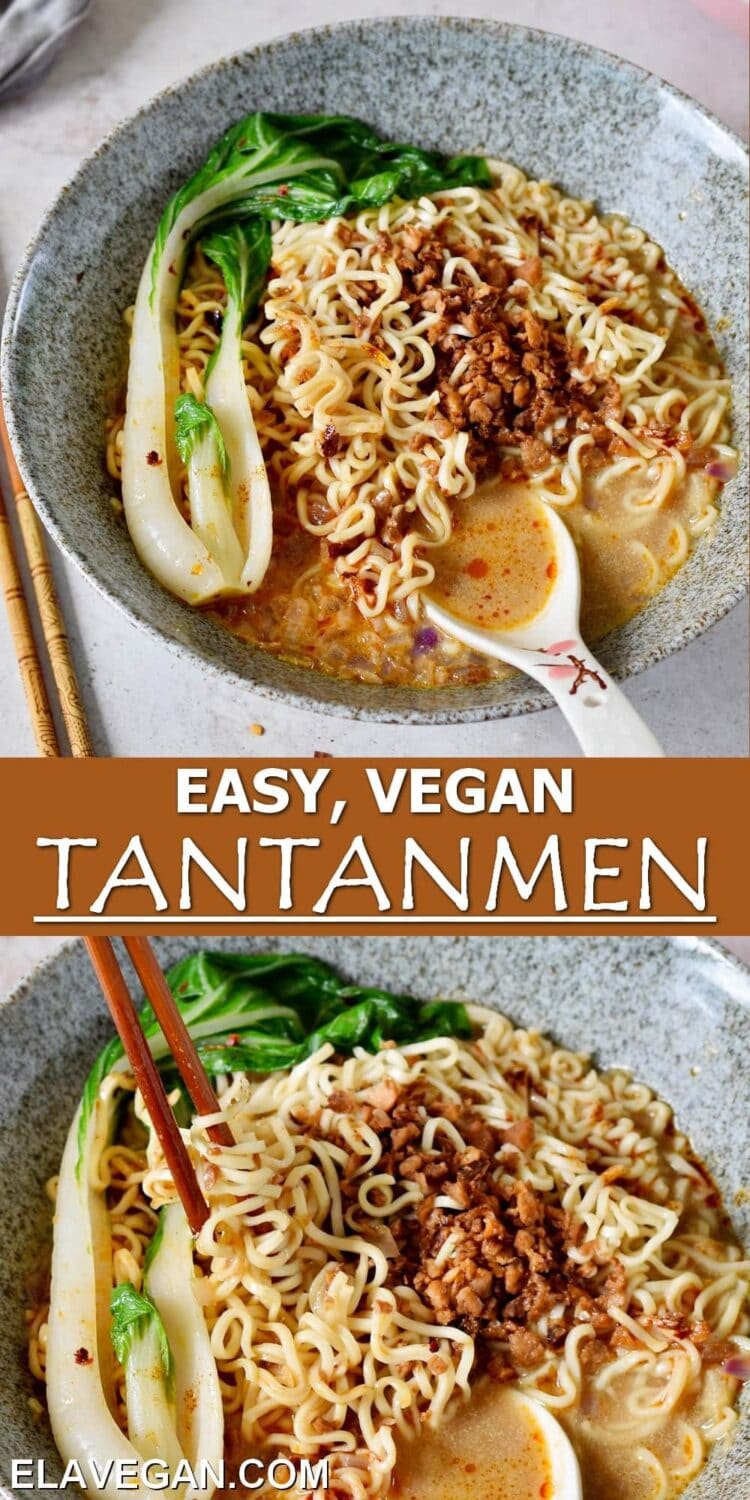
I wasn’t sure about this, as the soy milk i used split and became curdled but as soon as I had the first taste I was pleasantly surprised. So very yum! The flavours come together really well. Thanks for sharing
You are welcome! I am so glad you liked it. 🙂
sorry just saw this now will be making this soon i never had ramen before perfect for raining days in Singapore and after office meals will dm you if i make this and let you know how it goes Thanks Ramya
No worries, enjoy it! 🙂
I made this recipe and came back to review it, because it is so easy and SO delicious. No need to seek out restaurant ramen, friends… here is a swoon-worthy option that is ready fast, and great for a family meal or for company (when we can have company again, it being C.ovid-times now). I used frozen tofu! Added some mushrooms and bean sprouts, and served with homemade kimchi. This recipe will be a go-to from now on.
Hey! Thanks so much for your great feedback! So happy you liked it. 🙂